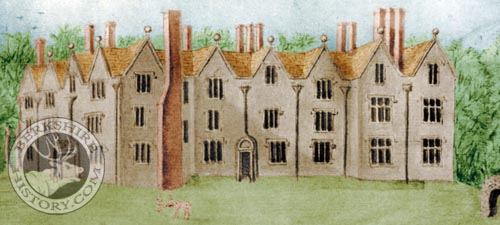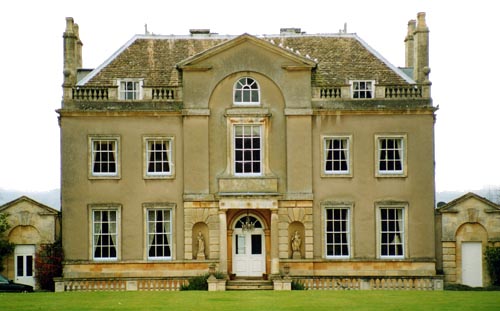 |
 |
|||
|
|
Faringdon House stands near the parish church of All Saints, on the edge of the small town after which it is named. There was no doubt a medieval building somewhere in the grounds, the manor farmhouse that Beaulieu Abbey rented out to tenants like Thomas Faringdon (d. 1396) whose memorial brass can be seen in the church. In the 1590s, Sir Henry Unton, the English Ambassador to France, built a fine Elizabethan brick house between the site of the present building and the church. He lived at nearby Wadley House in Littleworth, only a mile outside the town, but other members of the family may have used Faringdon. A 1620 inventory describes the houses's hall, parlour and a great chamber hung with arras and adorned with pictures. The gallery was hung with green. At the upper end were fifteen English pictures "hanged in tables". At the lower end were twenty-eight "pictures of Romans and Emperors" as well as two pairs of virginals. Sir Henry's widow, Dame Dorothy, lived there until her death, even though the estate had been sold to Sir Robert Pye in 1622. The Pyes took up residence in 1634. They were staunch Parliamentarians, Sir Robert representing Woodstock in the Long Parliament and his son, also Robert, marrying the daughter of John Hampden. Their son, Hampden, is said to haunt the churchyard. During the Civil War, because of Faringdon's strategic position, the Royalist army garrisoned the town with 300 troops from May 1644 and prevented western supplies from reaching Parliamentary Abingdon. Col. Sir George Lisle fortified Faringdon House as his headquarters until, in the following April, Oliver Cromwell arrived on the scene with a force of cavalry supported by 600 foot soldiers from Abingdon. Cromwell overran the town but, despite a ferocious attack, failed to take the house. Soon afterwards, Col. Marmaduke Rawdon replaced Lisle at Faringdon and his troops harassed the Parliamentary soldiers in the nearby towns so much that the taking of Faringdon was ordered. In April 1646, the younger Sir Robert Pye commanded the Parliamentary army that attacked, not only the town, but his father's own house. The assaults were unnsuccessful however and a two month siege ensued. On 24th June, the King ordred his garrison to surrender under the Articles of Oxford. During all this action, the house suffered considerable damage, although descriptions of it as being "in ruins" are probably exagerated.
In 1930, Gerald Tyrwhitt-Wilson, the 14th Baron Berners, moved in to Faringdon House. He was an accomplished writer, painter and composer. Stravinsky thought he was the best British composer of the 20th century. He was also a great British eccentric and, in 1935, built Faringdon Folly, one of the latest follies in the country. He kept a glittering social circle around him and parties at Faringdon were "like living a perpetual April Fool's Day, " often including John Betjeman, Salvador Dali, Aldous Huxley, Nancy Mitford, Diana Mosley, Edith Sitwell, Igor Stravinsky, HG Wells and others. Faringdon House is a private residence. It stands behind high walls next to the parish church.
|
|||
| © Nash Ford Publishing 2002. All Rights Reserved. This country house is located in a parish now administered by Oxfordshire County Council. | ||||



 Faringdon
House
Faringdon
House Old
Faringdon House was patched up by the later Pyes but suffered a serious fire
in 1766 and, as it was considered old-fashioned,
Old
Faringdon House was patched up by the later Pyes but suffered a serious fire
in 1766 and, as it was considered old-fashioned,